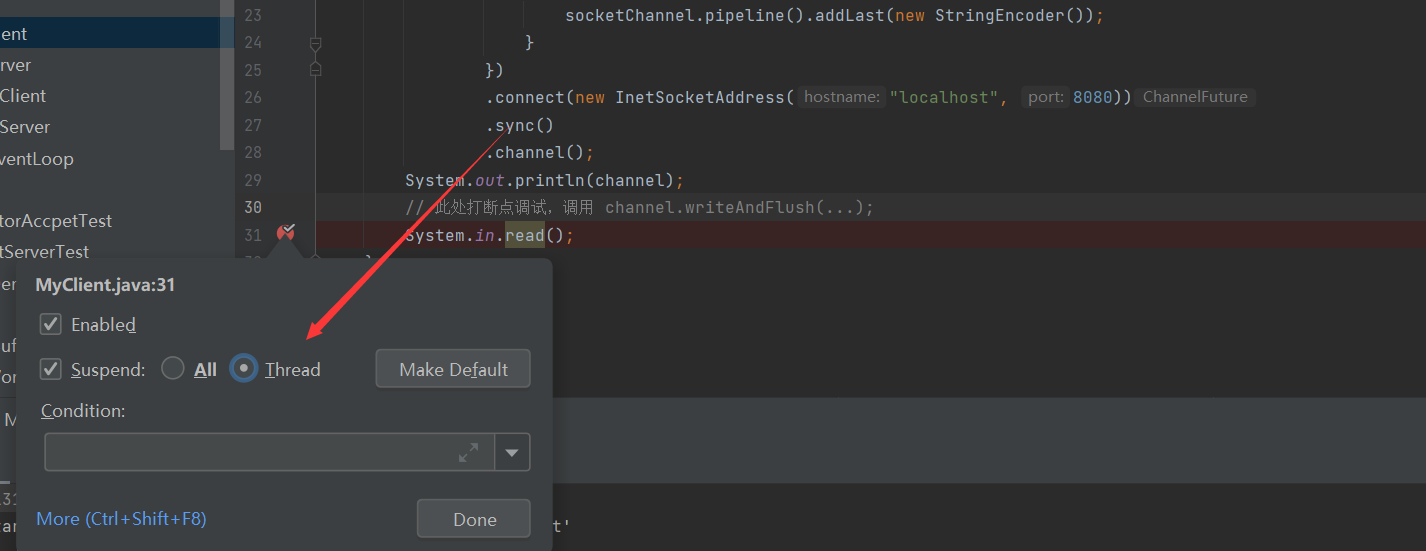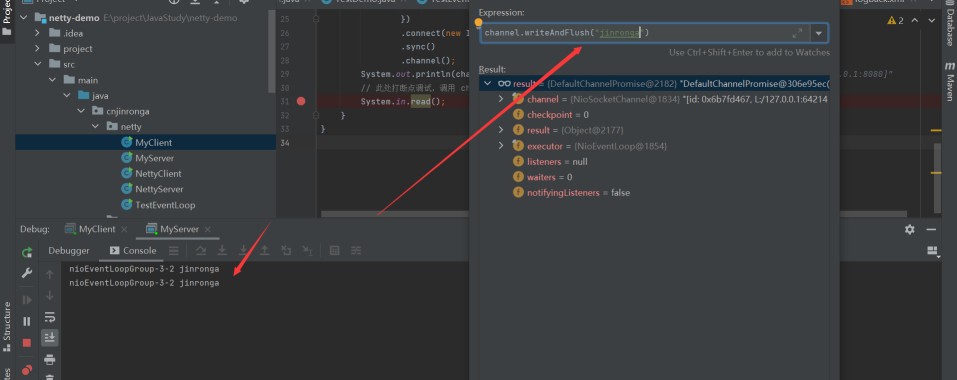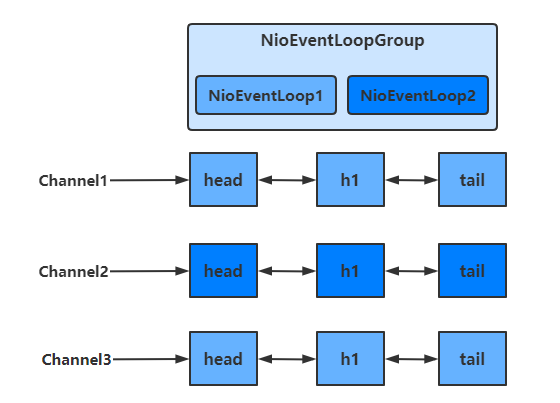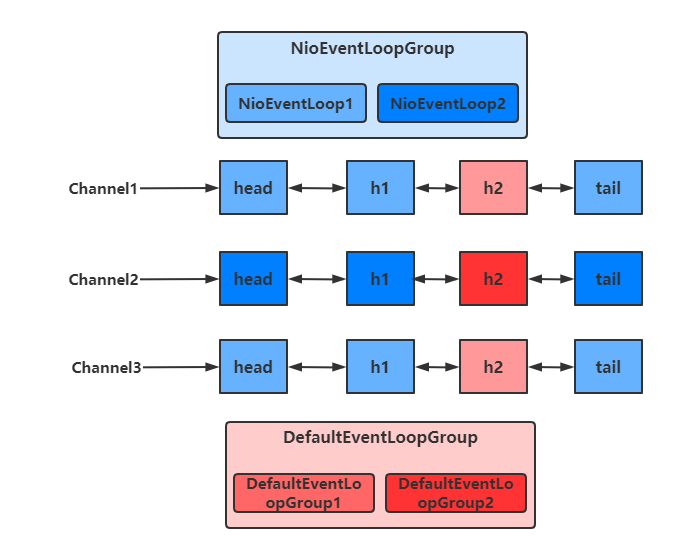一、Netty中的EventLoop
1、EventLoop组件
事件循环对象 EventLoop
EventLoop 本质是一个单线程执行器(同时维护了一个 Selector),里面有 run 方法处理一个或多个 Channel 上源源不断的 io 事件
它的继承关系如下
-
继承自 j.u.c.ScheduledExecutorService 因此包含了线程池中所有的方法
-
继承自 netty 自己的 OrderedEventExecutor
-
提供了 boolean inEventLoop(Thread thread) 方法判断一个线程是否属于此 EventLoop
-
提供了 EventLoopGroup parent() 方法来看看自己属于哪个 EventLoopGroup
事件循环组 EventLoopGroup
EventLoopGroup 是一组 EventLoop,Channel 一般会调用 EventLoopGroup 的 register 方法来绑定其中一个 EventLoop,后续这个 Channel 上的 io 事件都由此 EventLoop 来处理(保证了 io 事件处理时的线程安全)
-
继承自 netty 自己的 EventExecutorGroup
-
实现了 Iterable 接口提供遍历 EventLoop 的能力
-
另有 next 方法获取集合中下一个 EventLoop
处理普通与定时任务
public static void eventLoop() {
// 创建拥有两个EventLoop的NioEventLoopGroup,对应两个线程
EventLoopGroup eventExecutors = new NioEventLoopGroup(2);
//通过next方法可以获得下一个EventLoop
System.out.println("eventExecutors.next() = " + eventExecutors.next());
System.out.println("eventExecutors.next() = " + eventExecutors.next());
System.out.println("eventExecutors.next() = " + eventExecutors.next());
System.out.println("eventExecutors.next() = " + eventExecutors.next());
// 通过EventLoop执行普通任务
eventExecutors.next().execute(() -> {
System.out.println(Thread.currentThread().getName() + "你好!");
});
//通过Eventloop执行定时任务
eventExecutors.next().scheduleAtFixedRate(() -> {
System.out.printf(Thread.currentThread().getName() + ",你好!");
}, 0, 1, TimeUnit.SECONDS);
//关闭
eventExecutors.shutdownGracefully();
}
输出结果如下:
eventExecutors.next() = io.netty.channel.nio.NioEventLoop@43bc63a3
eventExecutors.next() = io.netty.channel.nio.NioEventLoop@702657cc
eventExecutors.next() = io.netty.channel.nio.NioEventLoop@43bc63a3
eventExecutors.next() = io.netty.channel.nio.NioEventLoop@702657cc
nioEventLoopGroup-2-1你好!
关闭 EventLoopGroup
优雅关闭 shutdownGracefully 方法。该方法会首先切换 EventLoopGroup 到关闭状态从而拒绝新的任务的加入,然后在任务队列的任务都处理完成后,停止线程的运行。从而确保整体应用是在正常有序的状态下退出的
处理IO任务
服务器代码
public class MyServer {
public static void main(String[] args) {
new ServerBootstrap()
.group(new NioEventLoopGroup())
.channel(NioServerSocketChannel.class)
.childHandler(new ChannelInitializer<SocketChannel>() {
@Override
protected void initChannel(SocketChannel socketChannel) throws Exception {
socketChannel.pipeline().addLast(new ChannelInboundHandlerAdapter() {
@Override
public void channelRead(ChannelHandlerContext ctx, Object msg) throws Exception {
ByteBuf buf = (ByteBuf) msg;
System.out.println(Thread.currentThread().getName() + " " + buf.toString(StandardCharsets.UTF_8));
}
});
}
}).bind(8080);
}
}
客户端代码
public class MyClient {
public static void main(String[] args) throws InterruptedException, IOException {
Channel channel = new Bootstrap()
.group(new NioEventLoopGroup())
.channel(NioSocketChannel.class)
.handler(new ChannelInitializer<SocketChannel>() {
@Override
protected void initChannel(SocketChannel socketChannel) throws Exception {
socketChannel.pipeline().addLast(new StringEncoder());
}
})
.connect(new InetSocketAddress("localhost", 8080))
.sync()
.channel();
System.out.println(channel);
// 此处打断点调试,调用 channel.writeAndFlush(...);
System.in.read();
}
}


分工
Bootstrap的group()方法可以传入两个EventLoopGroup参数,分别负责处理不同的事件(可以设置为cpu核心数乘以2)
打开两个客户端,debug发送数据给Server
public class MyServer {
public static void main(String[] args) {
new ServerBootstrap()
// 两个Group,分别为Boss 负责Accept事件,Worker 负责读写事件
.group(new NioEventLoopGroup(1), new NioEventLoopGroup(2))
...
}
}
可以看出,一个EventLoop可以负责多个Channel,且EventLoop一旦与Channel绑定,则一直负责处理该Channel中的事件

增加自定义EventLoopGroup
当有的任务需要较长的时间处理时,可以使用非NioEventLoopGroup,避免同一个NioEventLoop中的其他Channel在较长的时间内都无法得到处理
public static void customEventLoopGroup() {
// 增加自定义的非NioEventLoopGroup
EventLoopGroup group = new DefaultEventLoopGroup();
new ServerBootstrap()
.group(new NioEventLoopGroup(1), new NioEventLoopGroup(2))
.channel(NioServerSocketChannel.class)
.childHandler(new ChannelInitializer<SocketChannel>() {
@Override
protected void initChannel(SocketChannel socketChannel) throws Exception {
// 增加两个handler,第一个使用NioEventLoopGroup处理,第二个使用自定义EventLoopGroup处理
socketChannel.pipeline().addLast("nioHandler", new ChannelInboundHandlerAdapter() {
@Override
public void channelRead(ChannelHandlerContext ctx, Object msg) throws Exception {
ByteBuf buf = (ByteBuf) msg;
System.out.println(Thread.currentThread().getName() + " " + buf.toString(StandardCharsets.UTF_8));
// 调用下一个handler
ctx.fireChannelRead(msg);
}
})
// 该handler绑定自定义的Group
.addLast(group, "myHandler", new ChannelInboundHandlerAdapter() {
@Override
public void channelRead(ChannelHandlerContext ctx, Object msg) throws Exception {
ByteBuf buf = (ByteBuf) msg;
System.out.println(Thread.currentThread().getName() + " " + buf.toString(StandardCharsets.UTF_8));
}
});
}
})
.bind(8080);
}
启动四个客户端发送数据
nioEventLoopGroup-4-1 hello1
defaultEventLoopGroup-2-1 hello1
nioEventLoopGroup-4-2 hello2
defaultEventLoopGroup-2-2 hello2
nioEventLoopGroup-4-1 hello3
defaultEventLoopGroup-2-3 hello3
nioEventLoopGroup-4-2 hello4
defaultEventLoopGroup-2-4 hello4
可以看出,客户端与服务器之间的事件,被nioEventLoopGroup和defaultEventLoopGroup分别处理

切换的实现
不同的EventLoopGroup切换的实现原理如下
由上面的图可以看出,当handler中绑定的Group不同时,需要切换Group来执行不同的任务
static void invokeChannelRead(final AbstractChannelHandlerContext next, Object msg) {
final Object m = next.pipeline.touch(ObjectUtil.checkNotNull(msg, "msg"), next);
// 获得下一个EventLoop, excutor 即为 EventLoopGroup
EventExecutor executor = next.executor();
// 如果下一个EventLoop 在当前的 EventLoopGroup中
if (executor.inEventLoop()) {
// 使用当前 EventLoopGroup 中的 EventLoop 来处理任务
next.invokeChannelRead(m);
} else {
// 否则让另一个 EventLoopGroup 中的 EventLoop 来创建任务并执行
executor.execute(new Runnable() {
public void run() {
next.invokeChannelRead(m);
}
});
}
}
- 如果两个 handler 绑定的是同一个EventLoopGroup,那么就直接调用
- 否则,把要调用的代码封装为一个任务对象,由下一个 handler 的 EventLoopGroup 来调用